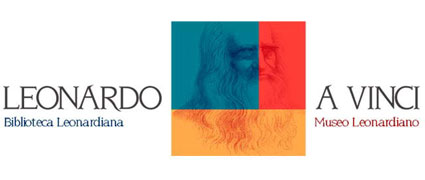 |

 |

| Newsletter N° 08 | 27/05/2004 |
Leonardo and Optics in Vinci International Study Day on the occasion of the inauguration of the new optics room of the Museo Leonardiano Vinci Biblioteca
Leonardiana e Museo Leonardiano Saturday 4 June 2005, 10 a.m. - 1 p.m.
Leonardo and optics from the Middle Ages to the Renaissance Having embarked on the study of optics in order to solve problems relating to the pictorial representation of three-dimensional figures, Leonardo dealt with the numerous and heterogeneous theories of his predecessors, developing his own original line of research that was independent from the dominant ideas of his age. One area of fundamental importance was his systematic study of shadows. He devoted an entire chapter to the subject in his Treatise on Painting, examining the distinction between various kinds of light and shadow, and the codices of the French Institute contain an incredible number of studies designed to measure the intensity of light, accompanied by acute observations about the reciprocal influence of shadows and colours. However, the field in which Leonardo’s work is of particular interest is his study of reflection and refraction: he experimented with flat and convex mirrors, designed ingenious instruments with which he resolved problems of geometrical optics and produced models to explain specific aspects of the behaviour of light. He also conducted interesting experiments with lenses, and was one of the first people to illustrate the concept of contact lenses to improve eyesight. Leonardo investigated the mechanisms of sight and made use of geometry and direct sensory observation in his search for answers; this was in strong contrast with all those who, in his age, advanced doubts about the veracity of such observations: “The eye, which is called the window of the soul, is the principal means by which the central sense can most completely and abundantly appreciate the infinite works of nature…” . However, Leonardo’s interest in vision certainly did not stop there; analyzing the enormous body of experiments conducted with the camera obscura, one can observe the adoption of an experimental method worthy of the modern age. Carrying out the same experiment repeatedly and changing a single parameter each time, he investigated the laws of nature in various fields: astronomy, light and shadow, the theory of vision. The new room of the Museo Leonardiano devoted to Leonardo’s studies of optics contains exhibits that piece together some of the main aspects of the long and fruitful studies that occupied him throughout his life, ranging from his experiments into light and shadow to the more general studies of the interaction between light and objects and his investigations of the visual process, the anatomy of the eye and optical illusions. A fitting conclusion to all this is a virtual reconstruction of his experiments with the camera obscura, which represent a synthesis of all his research and an admirable example of experimental method. The word ‘experiment’ itself, when referred to Leonardo’s work, assumes connotations similar to modern-day ones. By focusing on Leonardo’s studies in the historical context in which he operated, the aim of the exhibits is to show how the majority of the fundamental ideas that have led to advances in our understanding of optics found expression in Leonardo’s multifarious activities. .
|
programme Leonardo and Optics in Vinci International Study Day on the occasion of the inauguration of the new optics room of the Museo Leonardiano Vinci,
Biblioteca Leonardiana
10 a.m.
Dario Parrini, Mayor of Vinci 10.30 a.m. Kim Veltman 11.15
a.m. Tito Arecchi 11.45
a.m. Romano Nanni 12.10 noon Linda Luperini 12.30 noon Alexander Neuwhal The
optics of Leonardo between Alhazen and Kepler inauguration
of the new optics room in the Museo Leonardiano
Vinci, Museo Leonardiano/Castello dei Conti Guidi, 12.45
|
||
To
unsubscribe from the newsletter Leonardo a Vinci send an e-mail to: biblioteca@comune.vinci.fi.it
with the subject: Delete me from the mailing list of the newsletter Leonardo a Vinci